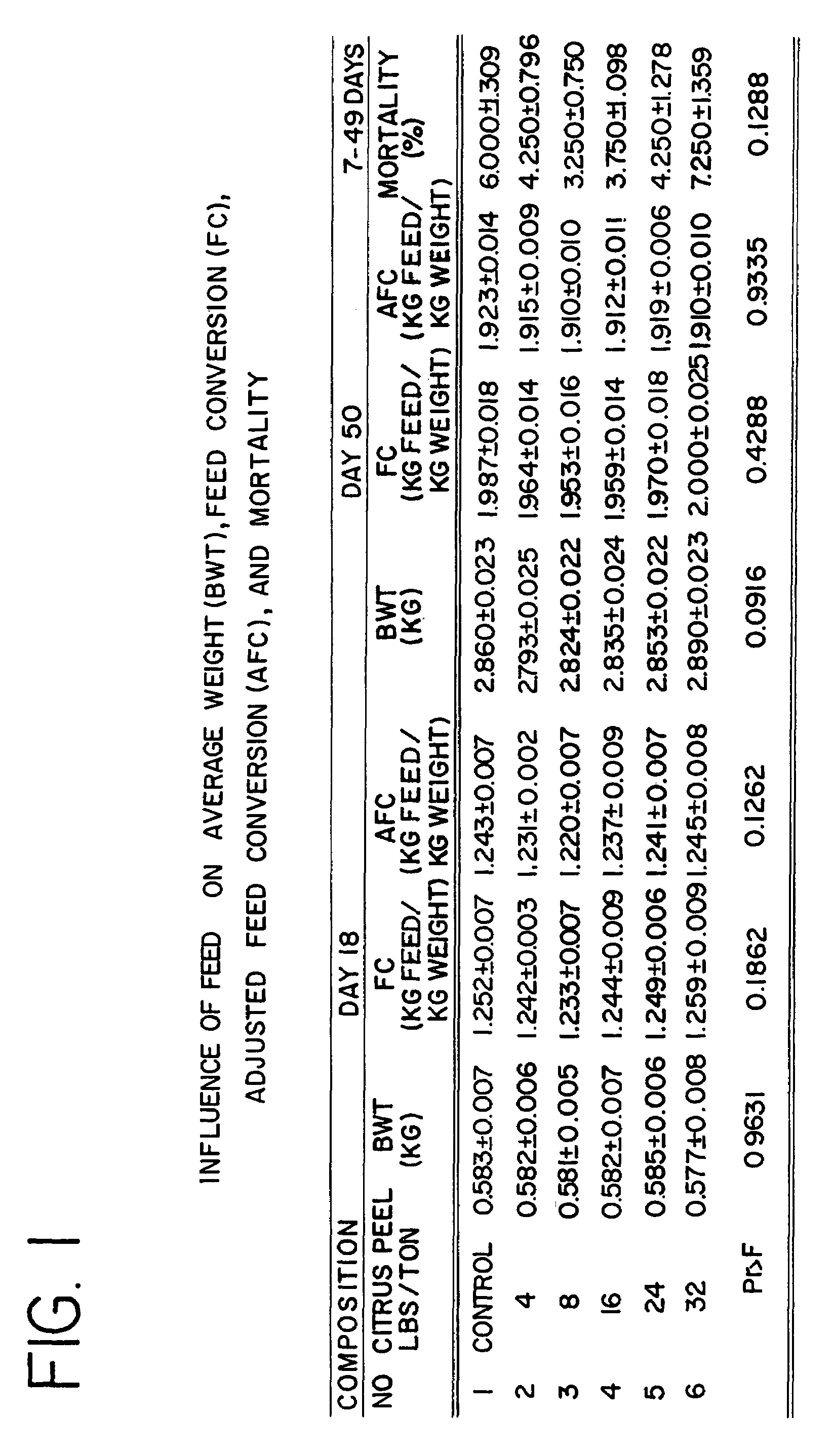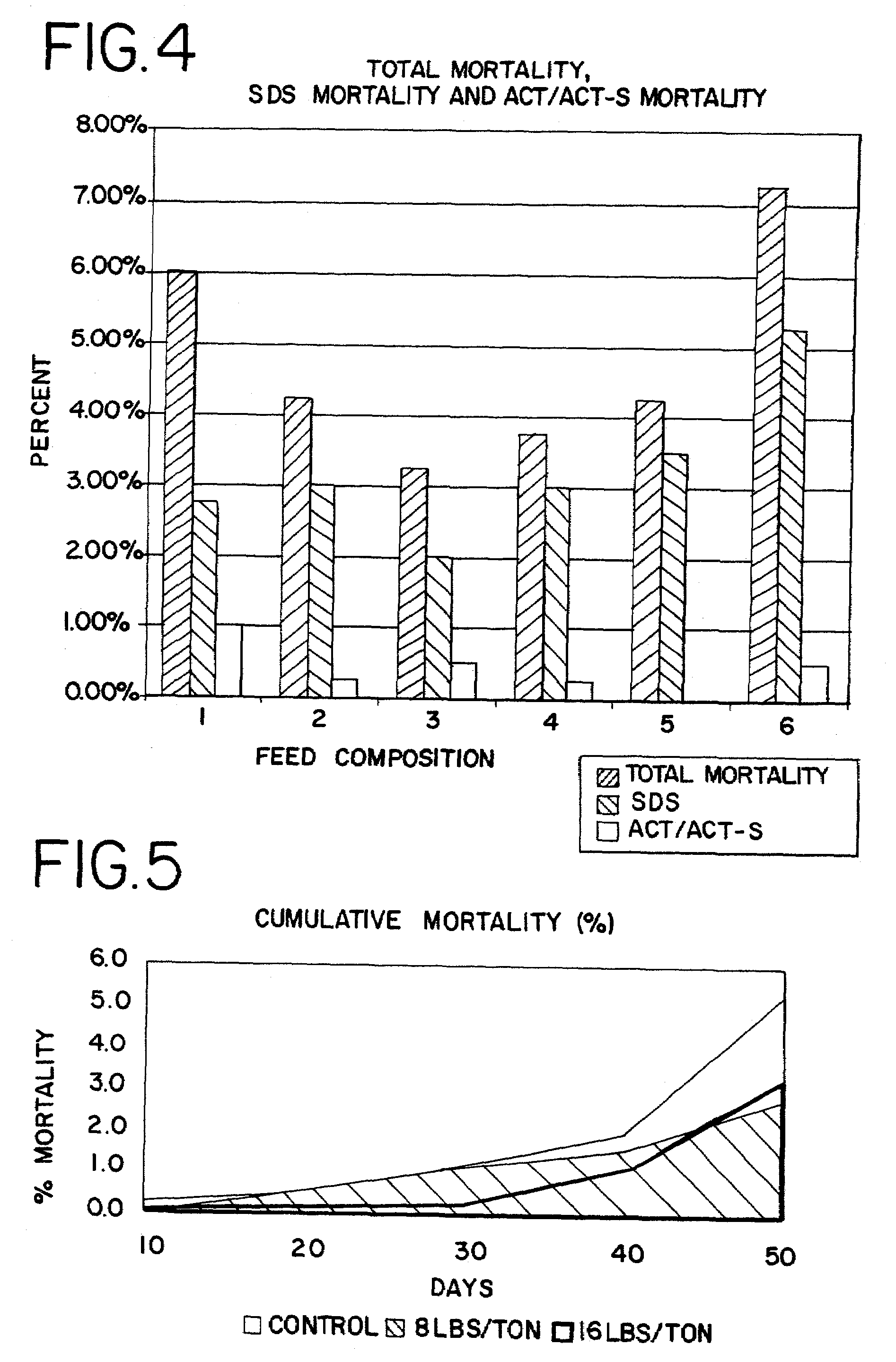Dried citrus peel supplement for use in commercial poultry feed
- Summary
- Abstract
- Description
- Claims
- Application Information
AI Technical Summary
Benefits of technology
Problems solved by technology
Method used
Image
Examples
example 1
[0058]A study was conducted to evaluate poultry feed formulations for broiler chickens placed upon traditional shaved pine litter within pens of the type typically used in poultry raising facilities. The testing was carried out over a typical growing period for broiler chickens, while monitoring certain parameters of importance to the poultry industry. The testing protocol strove to maintain all environmental, feeding and other conditions consistent for all birds, with the exception of the diet feed composition.
Study Protocol
[0059]In accordance with typical industry practices, the diets for each pen were varied as follows. For days 0 through 18, the birds were given a 22 percent starter diet in crumbled form. 1,100 pounds of feed containing a coccidiostat feed additive (salinomycin at 50 grams per ton) were prepared for early feeding. During days 18 through 35, a grower diet containing 20 percent pelleted grower feed formulation was combined with the basal feed containing the same f...
example 2
[0088]Chicken broilers were fed feed compositions containing varying levels of citrus peel. The citrus peel was provided as pellets, which were ground using a corn grinder. In all but the control, this ground peel was mixed with the basal feed having an approximate nutrient composition of 6.0 percent protein, 2.0 percent fat, 16.6 percent fiber and 3.0 percent calcium. The diets were fed ad libitum, the same diet being fed for days 0 through 15 in the case of each diet composition. No other feed additives were included in the diets. Commercial broiler chickens, Cobb×Cobb 0 or 1 days of age, were used. The respective feed was provided for 144 birds for each feed composition, there being 12 birds per cage.
[0089]The feed compositions were as follows: Composition 1 was the control, having no citrus supplement added thereto. Feed Composition 2 had 4 pounds per ton of a supplement of the citrus peel blended thereinto. Composition 3 had 16 pounds per ton of the citrus feed supplement added...
example 3
[0094]A battery cage study was conducted with poultry as generally discussed in Example 2 and with a protocol substantially as discussed in Example 2. Here, the study lasted for 27 days, and the diets differed from those of Example 2 in the following respects. Composition 1 continued to be the control feed having no added citrus supplement. Composition 2 added 8 pounds per ton (0.4 weight percent) of the ground citrus byproduct described in Example 2. Each of feed Compositions 3, 4 and 5 were supplemented with isolated and purified compounds which are found in citrus peel byproduct. Composition 6 contained a supplement which was a combination of these three chemical compounds. Each of the compositions was formulated so that the respective feeds were isocaloric.
[0095]More particularly, Composition 3 contained 104 ppm of hesperidin. Composition 4 contained 4.3 ppm of limonin glucoside. Composition 5 contained 0.12 weight percent of citrus pectin, based on the total weight of this feed...
PUM
 Login to View More
Login to View More Abstract
Description
Claims
Application Information
 Login to View More
Login to View More - R&D
- Intellectual Property
- Life Sciences
- Materials
- Tech Scout
- Unparalleled Data Quality
- Higher Quality Content
- 60% Fewer Hallucinations
Browse by: Latest US Patents, China's latest patents, Technical Efficacy Thesaurus, Application Domain, Technology Topic, Popular Technical Reports.
© 2025 PatSnap. All rights reserved.Legal|Privacy policy|Modern Slavery Act Transparency Statement|Sitemap|About US| Contact US: help@patsnap.com



